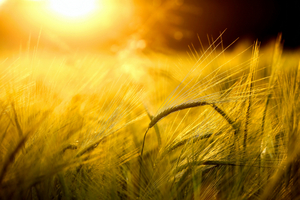The Firstfruits of Those Asleep
Reishit Qatzir [the beginning of the harvest] is sometimes called Yom HaBikkurim, the day of first fruits, and it provides a picture of Messiah in several ways. The first we've already noted: it shows us the need for a mediator. The second is found in the offering itself.
When the time of the harvest had come, when the first of the crop was ready, it was cut down and brought before G-d through the mediation of the priest.
When the time of the Messiah had come, when the firstborn of all Creation was ready, He was cut down and slain. The offering of His own life was made before G-d the Father. Messiah was both the offering and the priest Who offered it! (Hebrews 7:27)
Paul describes the Master in these terms in his first letter to the believers at Corinth:
For if the dead are not raised, not even Christ has been raised; and if Christ has not been raised, your faith is worthless; you are still in your sins. Then those also who have fallen asleep in Christ have perished. If we have hoped in Christ in this life only, we are of all men most to be pitied. But now Christ has been raised from the dead, the first fruits of those who are asleep. For since by a man came death, by a man also came the resurrection of the dead. For as in Adam all die, so also in Christ all will be made alive. (1 Corinthians 15:16-22)
Messiah is the firstfruits of those who are asleep (i.e. dead). When we are baptized in His Name then we are baptized into Messiah's death and raised again to walk in newness of life (Romans 6:4). We also become part of the harvest of which the Messiah is the first portion. As we examine this moed and consider the lifting up and waving of the sheaf from the crops, we should think of the "lifting up" of Messiah as He arose from the dead.
The day after the Sabbath
Consider the specific instruction regarding the Reishit Qatzir:
Then the LORD spoke to Moses, saying, "Speak to the sons of Israel and say to them, 'When you enter the land which I am going to give to you and reap its harvest, then you shall bring in the sheaf of the first fruits of your harvest to the priest. He shall wave the sheaf before the LORD for you to be accepted; on the day after the sabbath the priest shall wave it. Now on the day when you wave the sheaf, you shall offer a male lamb one year old without defect for a burnt offering to the LORD. Its grain offering shall then be two-tenths of an ephah of fine flour mixed with oil, an offering by fire to the LORD for a soothing aroma, with its drink offering, a fourth of a hin of wine.'" (Leviticus 23:9-13)
The time for the offering is "the day after the sabbath". Messiah Yeshua arose on the day after the Sabbath... early on the first day of the week (Matthew 28:1, Mark 16:2, etc) before sunrise while it was still dark (John 20:1). On the day of Messiah's resurrection, the priest was required to bring:
- the grain from the beginning of the harvest (the firstfruits)
- an unblemished male lamb
- an unleavened grain offering (matzah)
- a drink offering of wine
Think of it! From the time Israel entered the promised land until the destruction of the Temple in 70 AD, the Levitical priests honored the work of Messiah each year by lifting up the firstfruits of the harvest and offering an unblemished male lamb (pictures of Messiah!) along with unleavened bread and wine (elements of "the last supper")!
Each moed provides us with wonderful pictures of the Person and work of our Messiah!
Let's see how tradition has also beautified the moed.
